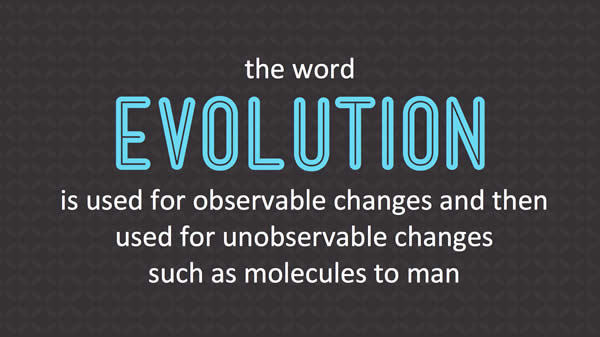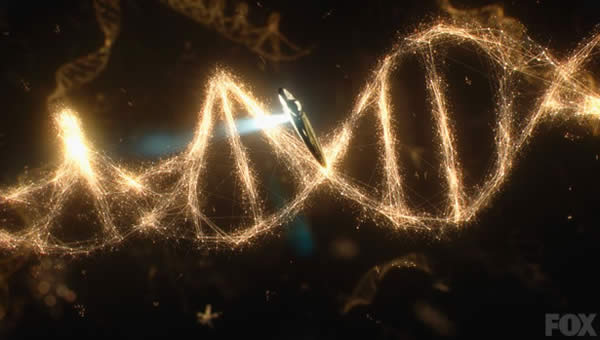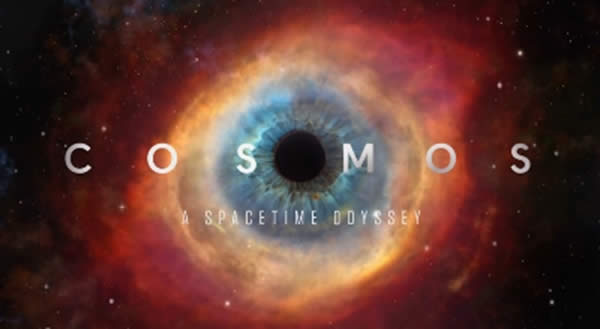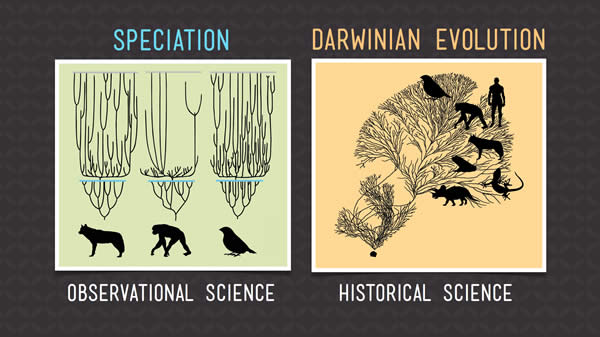
Cosmos Review: “Some of the Things Molecules Do”
Episode Two of Cosmos: A SpaceTime Odyssey
Cosmos Articles and Discussion Guides
See Cosmos: A SpaceTime Odyssey for reviews of other episodes and discussion guides for further study.
The Science of Speciation
Cosmos host Neil deGrasse Tyson opens with a story to illustrate how dogs may have been domesticated from a wolf ancestor and then undergone artificial selection to produce all the species of dogs we see today. Biblical creationists have long said on the basis of God’s Word that all varieties of dogs likely originated from a single kind of dog.
Showing how a mutant bear’s white fur can make it easier to sneak up on prey, Tyson describes how a selective advantage, obtained through a random mutation, can lead to speciation through natural selection. Other than the inflated dates—drawn from the faulty assumptions and circular reasoning associated with molecular clock dating1—this segment of the program correctly shows how artificial or natural selection can produce new species and varieties of animals.
Molecules-to-Man Evolution: Speciation Writ Large?
After laying a brief foundation of observational science, the Cosmos infomercial promoting belief in billions of years of biological evolution began in earnest. Tyson said,
If artificial selection can work such profound changes in only ten or fifteen thousand years, what can natural selection do operating over billions of years?
The answer is all the beauty and diversity of life.
How does it work? Our ship of the imagination can take us anywhere in space and time. Even into the tiny microcosmos where one kind of life can be transformed into another.
Ken Ham recently described this tactic during the Nye-Ham Debate as a classic example of bait-and-switch with the word evolution. Species do change. In fact, nothing in the Bible even suggests otherwise. But evolutionists extrapolate from observable speciation to upward evolution because to do so suits their purposes.


As Ken Ham noted in the recent Nye-Ham Debate, the word evolution is used in two different senses, but then, illogically, its meaning in one context is used to support evolution in a completely different context. This deceptive ploy is used in the second episode of Cosmos, “Some of the Things Molecules Do.”
“Darwin discovered the actual mechanism of evolution,” Tyson claims. Darwin knew nothing of genetics, but like others he saw evidence of speciation in the natural world. Darwin then assumed that there must also be some way for creatures to evolve into more complex kinds of organisms. Tyson credits Darwin with de-bunking the belief in the fixity of species: “The prevailing belief was that the complexity, variety of life must be the work of an intelligent designer who created each of these millions of different species separately.” Incidentally, this false notion that some people (both inside and outside of the church) once held—that species were unchanging—came not from the Bible but from an infusion of Greek philosophy from Aristotle among the educated of the western world. (You can read more about the history of this incorrect idea in “Do Species Change?”)
Variation of organisms within their created kinds—which occurs on the basis of reshuffling, isolation, selection, and other mechanisms related to the genetic information contained in that kind of organism—does not, however, support the evolutionary emergence of completely different kinds of organisms. Nor can it, because mutations—not even lots and lots of them—do not create the new genetic information that would be required to produce a more complex kind of organism but only variations of the existing kinds.
“The Ancient Scripture of Our Genetic Code”
Since scientists have never observed the evolution of a new kind of organism, how can Cosmos host Tyson claim this process not only occurs but has produced “all the diversity of life”? The proof he offers is DNA. “The ancient scripture of our genetic code,” he says, “is written in a language that all life can read.”

The Cosmos’s “ship of the imagination” cruises along this DNA double helix. God designed all living things with their genetic information encoded using the same genetic “alphabet.” And because living things on Earth have the same basic needs and biochemical requirements, genes for many commonly needed proteins are understandably similar. If it were otherwise, their coexistence and interaction on the Earth would be problematic. Contrary to this understanding and on the basis of atheistic presuppositions, Cosmos teaches that a common genetic alphabet could only have come to exist through the natural evolution of all life-forms from a common ancestor. (Image courtesy of http://www.cosmosontv.com.)
Tyson briefly explains the DNA “alphabet”—the genetic code by which DNA blueprints the physical traits of living things—and how it gets copied from generation to generation. In the genetic alphabet, each small combination of nucleotides stands for a particular “letter” used to write instructions in each cell’s massive DNA code that tells it how to make more living cells and how to function. All living things on Earth use the same genetic alphabet to write these instructions. Evolutionists claim living things could only use the same alphabet if they all evolved from a common ancestor, which itself evolved from non-living matter. At the end of the program Tyson admits that the origin of DNA and of life itself remains an unsolved mystery but declares that not being able to explain how living cells sprang from non-living elements through natural processes is not a problem. He does not mention that such abiogenesis violates the most fundamental law of biological science.
How do biblical creation scientists account for the consistency of the genetic alphabet?
So how do biblical creation scientists account for the consistency of the genetic alphabet? How can we explain the fact that some of the same genetic instructions for certain essential proteins and the processes they direct are seen in all living things? Tyson says, for instance, that the instructions for these essentials evolved before life branched off to different forms. But when we realize that God created all kinds of living things to function in the same world, to subsist on the same raw materials from the environment, and to interact with each other, it makes sense that He would create a system to make the biochemistry of all living things on Earth consistent and compatible. Otherwise, how could ecosystems ever be established? How could anything find biochemically compatible food to eat? God designed all the living things in His Creation to function within His Creation.
Mutations—Not the Raw Material for Evolution
Cosmos host Tyson correctly says that genetic copying errors—mutations—can be inconsequential, deadly, or even helpful in certain environments and circumstances. Such genetic differences—mutations—“provide the raw material for natural selection,” he says. While natural selection does operate on the fitness or unfitness of various traits that sometimes appear as a result of mutations, the resulting organisms are only variations of the original kind.
What Tyson fails to reveal is that mutations never produce new information such as would be needed to produce a different kind of organism. The “raw material” provided by mutations is not new information, just recycled old information. When natural selection eliminates certain varieties of organisms from a population, as sometimes happens, the genetic information in the population may even be lost. Thus, mutations do not provide the “raw material” for molecules-to-man evolution.
Furthermore, it is only the evolutionary presupposition that all life shares a common ancestor that prompts evolutionists to attribute the differences between life-forms to information-adding mutations. A mutation is a change, and mutations are common occurrences. However, God designed each kind of animal and plant with its own genetic information. Differences between the genomes of the original created kinds are the result of God’s design, not mutations as Cosmos maintains.
Dr. Georgia Purdom, molecular geneticist at Answers in Genesis, explains it this way:
Tyson indicated that all evolution needs is time. That small changes that led to different species and breeds of dogs and different species of bears would, given enough time, lead to changes of one kind of animal into a different kind of animal (like dinosaurs evolving into birds). However, time is not the key. A genetic mechanism that adds information necessary to go from molecules to man is the key. The evolutionists can have all the time in the world but if they do not have a genetic mechanism they will get nowhere.
To illustrate how mutations supposedly provided what it took to build something wondrously complex, Cosmos gives us the human eye, morphing from an anatomical eye to the Helix Nebula that forms the icon for the program. Lining up a number of organisms with light-sensing structures, Cosmos seeks to show that evolutionary scientists have worked out the evolutionary origin of the human eye’s complexity. Cosmos instead merely shows a gallery of creatures that God designed equipped to sense and react to light according to their various needs. Nothing about the genetic differences between the various creatures with light-sensing structures can explain how a mutation here and there could add onto the genetic information in a creature to produce a different kind of creature or build a new kind of eye, much less the brain to analyze and interpret the information gathered by the eye.

The eye-like Helix Nebula is the icon for Cosmos: A SpaceTime Odyssey. The program teaches that the human eye evolved through the accumulation of mutations beginning with a mutation producing the first light-absorbing protein in a microbial ancestor. (Titlecard for Cosmos television program. Courtesy of Wikipedia, http://en.wikipedia.org/wiki/File:Cosmos_spacetime_odyssey_titlecard.jpg.)
This episode claims to teach viewers “Some of the Things Molecules Do.” In reality it teaches that something biologists have never observed has not only happened but has happened so often and for so long that it produced all biological diversity. Tyson teaches that given enough time for helpful mutations to accumulate, new kinds of organisms evolve. This does not actually occur. These are some things molecules do not do! But then, the purpose of this program is not to actually teach the knowledge of what is but rather to indoctrinate with the interpretations evolutionists want people to imbibe.
Commenting on the Cosmos account of eye evolution, Dr. Purdom adds:
I always get disgusted when I see evolutionists “explain” eye evolution to the public. They line up organisms from “simple” to complex and show different eyes and make it sound like an easy seamless progression from a simple to complex eye. They deceive the public by not telling them all the changes that would have to occur at the molecular level (DNA, proteins, cells) to make this happen. The only way their story can sound reasonable is if they leave out the details.
The “Soaring Spiritual Experience” of Insignificance
Continuing this flight of imagination, Tyson says, “The stuff of life is so malleable that once it got started the environment molded it into a staggering variety of life-forms.” Showing the evolutionary tree of life, he says, “Science has made it possible for us to construct this family tree for all the species of life on Earth.” Humans are but an insignificant little twig on the tree. We shouldn’t feel special, he says, and certainly not like special creations of an intelligent Designer!

Cosmos presents an evolutionary tree of life showing all living things as descendants of one single-celled common ancestor. This tree of life is not supported by biological observations, as organisms do not acquire the genetic information to evolve into new and more complex kinds of organisms. The absence of intermediate (transitional) forms between kinds of organisms likewise argues against the evolutionary tree of life. Biological observations show that animals and plants do vary but only within limits. Those limits are their kinds, which correspond within our classification systems often to roughly the level of the “family.” Therefore, reality corresponds to a “Creation Orchard” model in which each original kind of created plant or animal has its own family tree of species.
“A central premise of traditional belief is that we were created separately from all the other animals,” Tyson says. “It’s easy to see why this idea has taken hold. It makes us feel special.” Having thus rejected the biblical truth that humans—Adam and Eve and all who have descended from them—are made in the image of God (Genesis 1:26–27), Tyson shares his conviction: “Accepting our kinship with all life on Earth is not only solid science, it’s, in my view, also a soaring spiritual experience.”
While Tyson says “Come with me” as he finds spiritual exhilaration by arrogantly fancying himself intelligent enough to grasp his own insignificance (1 Corinthians 1:20–25), God our Creator offers a different path to significance, peace, and joy. Every one of us is a descendant of Adam and Eve. Like our first parents, each of us, though created in the image of God, is a sinner (Romans 3:23; 6:23). In spite of our rebellion against our Creator, each of us is the object of God’s unspeakable love (2 Corinthians 9:15; 2 Peter 3:9). Therefore, Jesus Christ the Son of God entered this world as a human being (John 1:1–5, 14; 1 John 1:1–3; 4:2–3), lived a sinless life (2 Corinthians 5:21), sacrificed Himself to redeem us (Romans 5:8) from the condemnation we deserve (John 3:16–17; 12:32; Hebrews 2:9–10), and provides eternal and abundant life (John 10:10) to all who repent and trust in Him.
For More Information
- Cosmos Review: “Standing Up in the Milky Way”
- Can Bible-Based Predictions Lead to Scientific Discoveries?
The Eye
- Visual Perception: More Than Meets the Eye
- The “Eyes” Have It
- The Seeing Eye
- Didn’t Darwin Call the Evolution of the Eye Absurd?
- Darwin vs. the Eye
- An Eye for Creation
- Evolution and Medicine
- Organ Recital: A Parade of Presumed Design Flaws Devoid of Truth
Mutations and Natural Selection
- From Bacteria to Giraffes: Adapting Reality to Fantasy
- Is Natural Selection the Same Thing as Evolution?
- Are There Beneficial Mutations?
- Did God Create Poodles?
Species and Kinds
- Variety Within Created Kinds
- Do Species Change?
- How Cavefish Went Blind, and Why It Matters
- Evolution of Snake Venom: A New Use for Old Genes?
- An Evaluation of the Myth That “Nothing in Biology Makes Sense Except in the Light of Evolution”
- How Could Noah Fit the Animals on the Ark and Care for Them?
- Mammalian Ark Kinds
Origin of Life
Footnotes
- Molecular clock dating is an exercise in circular reasoning that assumes molecules-to-man evolution happened in order to prove how long it took. It attributes the genetic differences between difference kinds of organisms to the accumulated mutations evolutionists believe caused one kind of animal (or plant or microbe) to evolve into a more complex one. This method assumes that mutation rates over great spans of time can be known and remain constant. The method is based on foundational data that suffers from the statistical mismanagement of error ranges as well as the assumption that one kind of creature in the fossil record evolved into another by accumulating mutations. Circular reasoning is also inherent in the calibration of the “clocks” in accord with the radiometric dating methods, creating the illusion of “confirmed” interpretations. For more information see “Circular Clock: Cambrian Secrets of Small Beginnings” and “Circular Reasoning Surrounds Human Origins, but Even a Broken Clock Is Right Twice a Day.”
Recommended Resources

Answers in Genesis is an apologetics ministry, dedicated to helping Christians defend their faith and proclaim the good news of Jesus Christ.
- Customer Service 800.778.3390
- Available Monday–Friday | 9 AM–5 PM ET
- © 2026 Answers in Genesis




